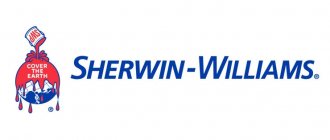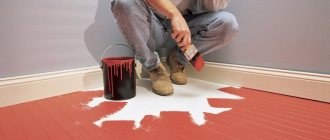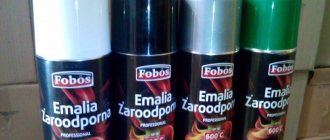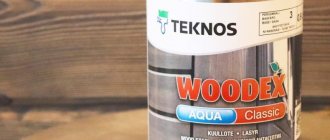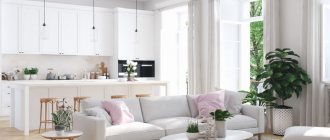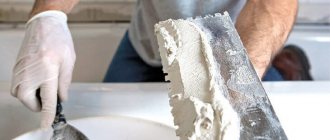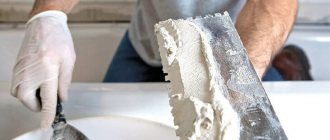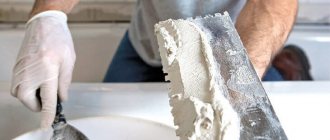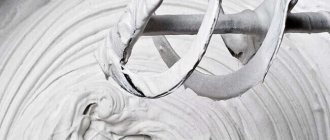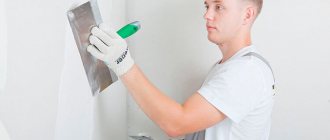SHARE ON SOCIAL NETWORKS
FacebookTwitterOkGoogle+PinterestVk
From this article you can learn about all the features that textured wall paint used in modern interiors has: the properties of the finishing material, its advantages and disadvantages, varieties, popular effects that can be created using the coloring composition, prices. The process of preparing walls and detailed technology for applying textured paint, including photo and video materials, will be considered.
Using textured paint you can achieve both a perfectly smooth surface and give the wall a unique decorative look.
Peculiarities
Despite the fact that paints are the oldest invention of mankind, decorative coatings appeared on the construction market relatively recently. They are a product of modern technology. Paints are sold in ready-to-use form. Their decorative effect lies in the special pattern that is formed on the walls due to the composition of the coating.
Having a velvety effect, they do not lose the smoothness of their surface, which allows them to be used for painting walls in rooms with increased sanitary and hygienic requirements (children's and medical institutions). The walls painted with them have an attractive surface that allows you to implement various design solutions.
Thanks to decorative paints, the walls of rooms can be given the appearance of sand dunes, antique surfaces, or given golden, silver, mother-of-pearl and other shimmers. They were invented specifically to create
wall surfaces of various patterns. Some types of coatings can, like chameleons, change their color depending on the lighting.
Using decorative paints you can achieve the following effect:
- silks;
- plasters;
- sand;
- velvet;
- granite and marble;
- metal
What colors are there?
Textured wall paint has a rich range of colors, primarily due to its wide tinting options. Most manufacturers of building materials produce paints in a single white color, allowing the buyer to choose the shade that best suits the design.
Important! To be able to repeat the color, order computer tinting in a store, or write down the proportions in grams, selecting the tone manually.
If the wall is covered with white paint, the volumetric effect will be almost invisible: to maintain the airiness of the finish, but emphasize the texture, after drying, use the technique of painting with a dry brush or sponge.
Textured paints in most interiors are made light: beige, gray. The palette fits many styles: Scandinavian, classic, minimalism. Loft lovers will like deep, rich shades: black, indigo, burgundy.
The emphasis on the painted wall is made using original, unusual shades: blue, pink, lilac (look for examples in the photo). For greater effect, experts recommend covering walls with textured paints with pearlescent and metallic effects.
Application area
Decorative paints are environmentally friendly and can be used to cover walls in any room and to decorate building facades. Most of the range produced by manufacturers is moisture resistant and can be used to create interior design in bathrooms and kitchens. Surfaces coated with them can be washed. This will not prevent them from retaining their brightness and texture.
In hospitals and industrial premises, decorative paints with increased chemical resistance are used to cover the surface of walls.
Leading manufacturers of decorative textured paints
When choosing textured paints, you need to focus on the manufacturer, since unverified companies may produce a low-quality product, which will affect the finishing result. We can note well-known companies that offer inexpensive formulations with a variety of effects:
- Amourcolor paints are the most popular, they have increased durability and a variety of shades;
- "Lakra" is a Russian manufacturer that produces high-quality relief textures;
- the famous one offers compositions with imitation of aged surfaces, silk, velvet;
- the VGT brand from the Russian Federation produces textures adapted to our climatic conditions;
- "Blancolor" produces durable textures with imitation silk surfaces and waxed plaster.
Paint for textured plaster with a “wet silk” effect
Advantages and disadvantages
In addition to moisture resistance, decorative paints have a number of other advantages. Among them is a good indicator of hiding power. It determines the number of layers of paint applied to the surface required to cover the substrate.
Among other advantages:
- harmlessness to human health and the environment;
- economical consumption;
- simplicity and ease of application on surfaces;
- good performance properties and long service life;
- does not peel off or crack;
- wide range of colors.
The main disadvantage of decorative paints is their high cost. They can only be applied to a carefully prepared surface.
How to care for wall decoration
Textured paints are less susceptible to the effects of water, dampness, and constant high humidity. Walls covered with this paint can be easily cleaned with water and a small amount of detergent. It is recommended to check the effect of the latter on an inconspicuous area somewhere in the corner.
There are practically no specialized detergents for such surfaces, so cleaning is done with soapy water, dish soap, and powders. After finishing cleaning, rinse the surface with clean water and wipe dry with a clean rag.
Classification
Decorative paints produced by manufacturers can be divided into 2 large groups:
- Mosaic.
- Special effect with a special structure.
Mosaic decorative paints imitate natural materials. They are applied to the surface of the walls using a spray gun. They contain insoluble colored fractions.
Special effect coatings have a special chemical composition. They may have luminescent properties.
Depending on the composition, decorative paints are divided into:
- Alkyd . The paintwork material contains alkyd resin. The coatings are moisture resistant and do not fade under the influence of ultraviolet rays. The walls painted with them have a shiny surface. The disadvantage of alkyd paints and varnishes is the long drying period and a sharp, unpleasant odor, which disappears over time. The main purpose is external finishing work.
- Adhesive . Paintwork materials are water based. They are not intended for painting walls in rooms with high humidity. The main purpose is painting concrete, brick and plastered walls. Walls coated with adhesive paints have matte surfaces.
- Water-based and emulsion . Paintwork materials of this group are resistant to fire, harmless to humans, and can be applied to any surface. The exception is walls coated with glue or varnish. Water-based and emulsion coatings are resistant to fading, do not have an unpleasant odor, dry quickly and do not lose their original color for a long time.
- Flock . Paintwork materials have an adhesive base. They are applied to the walls using a special sprayer in several layers in a certain order. When applied to walls, flock coatings mask cracks and scratches well.
- Mosaic . The composition of paintwork materials includes particles of different structure and size, which, after application to the surface of the walls, form a volume. Decorative paints of this type can be used to mask various wall imperfections. They are able to convey the tactile sensations of ceramic tiles, pile, etc.
- Latex . The paint composition contains rubber. It forms an elastic film on the surface of the walls that is resistant to fading and moisture. Latex decorative paint can be applied to any surface. The elasticity of the coating allows you to create any relief on the walls.
TOP 6 best
Studio Finishes Molten Metallics
Country of origin: USA. The decorative alkyd coating has... Used for painting walls. The coating has a metallic effect with a deep shine. Apply to walls in 1-2 layers using a roller, brush or spray. Drying time – 24 hours.
Advantages:
- environmental friendliness;
- wide range of shades;
- durability of the coating;
- moderate consumption;
- moisture resistance.
Main disadvantage:
- high price.
Tikkurila Joker
Country of origin: Finland. Premium water-based decorative paint. Designed for interior work. Recommended for allergy sufferers and asthmatics. Creates a silky surface on walls that can be washed. The Tikkurila Joker paint palette includes more than 20,000 shades.
Advantages:
- resistance to fading;
- environmental Safety;
- wide color palette;
- ease of application;
- moisture resistance.
Main disadvantage:
- high price.
Krastone M530
Country of origin: South Korea. Multicolor mosaic decorative paint is made on the basis of acrylic resins. Designed for application to concrete, brick, metal, cement surfaces and drywall. Can be used for painting walls in any type of room. Drying time is from 7 to 15 days.
Advantages:
- non-toxic;
- has no odor after drying;
- can be applied to windows, doors and furniture;
- resistant to fading and fire;
- moisture resistant;
- environmentally safe.
Main disadvantage:
- long drying time.
DESSA DECOR “Silk”
Country of origin: Russia. Decorative paint is water-based. It contains pearlescent pigment. It has the effect of soft silk, creating a feeling of lightness in the interior. By changing the angle of light reflection, the surface of the walls changes shades. Paints and varnishes are used to create interiors of various styles. Drying time – 8 hours.
Advantages:
- resistance to fading;
- ease of application on surfaces;
- prevents the appearance of fungus on walls in rooms with high air humidity;
- can be used as a decorative gel.
Main disadvantage:
- high price.
DUFA RETAIL EUROLATEX 3
Country of origin: Russia. Latex decorative paint is intended for painting walls and ceilings in rooms with moderate humidity. Can be applied to all types of surfaces, including paper and vinyl wallpaper. Paint-coated walls have deep matte surfaces. Drying time – 3 days.
Advantages:
- good hiding power;
- environmental Safety;
- efficiency;
- durability.
Main disadvantage:
- long period of complete drying.
Rauf Dekor RUNA
Country of origin: Russia. The basis of decorative paint is acrylic latex. DCM has a silk effect. Can be used for painting complex surfaces of any type. Drying time – 24-36 hours.
Advantages:
- has no smell;
- environmental Safety;
- fire resistance;
- efficiency.
No deficiencies identified.
Types of compositions
For interior work, you can use a huge number of textured mixtures, which differ not only in color palette, but also in composition.
Among the most popular textured paints there are several types.
- Missouri. Manufacturers use acrylic fillers, as well as modified starch, to make this paint. With the help of such compositions it is possible to obtain a relief coating with a wave-like pattern, which is created with a special roller. Pigments can be added to the mixture to add a glossy shine to the finished coating. The peculiarity of this composition is that it can be carried even by hand.
- Marseille wax. The composition is based on wax and polymer fillers. This paint dries quickly, allowing you to create the effect of aged natural stone with a pattern that imitates natural stone when applied. A properly dried coating has a glossy shine. The paint can be used to decorate different rooms - imitation of natural stone can elevate any interior.
- Wet silk. This mixture uses cotton fibers and cellulose. The polymer base in combination with high-quality pigments allows you to obtain a rich color and pronounced texture. The finished coating resembles velvet or velor fabric: with it you can create an atmosphere of real luxury.
Painting nuances
Decorative paints can be applied to surfaces only after careful preparation. They should not have cracks or irregularities. Before painting, the walls are covered with finishing or starting putty. Applying paint to a poorly primed surface will be extremely difficult. Its consumption will increase and over time the paint may peel off. The choice of method for applying decorative paint to surfaces depends on the type of paintwork material.
Expert opinion
Kukushkin Anatoly Sergeevich
Repair specialist
To obtain an ornament on the walls, they are first covered with a layer of paint, and then the planned ornament is applied to them using a textured roller. To obtain a combined coloring of walls, dyes of various colors and shades are prepared and applied to the walls one by one. Walls with different shades are obtained from one paint, successively adding different colors to it.
The aging effect is obtained by painting the walls in a single layer, and then applying colored glaze of a suitable shade to it. The skin effect is achieved in a similar way. The only difference is in the choice of color shade for colored glaze. The effect of Venetian plaster is achieved by randomly applying two shades of paint to the surface of the walls.
Questions and answers
What selection criterion should be the main one when purchasing decorative paint for a corridor?
Premises with heavy operational load are painted with high-gloss paint. For corridors, the paint gloss level should be 15-25%.
How to achieve a marble effect when painting walls with decorative paint?
The marble effect on the walls is achieved by first applying a layer of background paint to them, then using a wide brush to create uneven stripes of two primary colors. The veins are painted with a thin brush. To apply them, paint of the second layer is used.
Why are decorative paints better than wallpaper?
Unlike wallpaper, decorative paints are applied to the surface of the walls without seams. They do not absorb odors and do not fade in the sun.
What decorative paints can be used to paint a bathroom?
To paint walls in rooms with high air humidity, you need to use paints with a high content of film-forming agent. Moisture-resistant acrylic paints and varnishes have this composition.
Can decorative paint be used to paint a floor?
Decorative floor paints cannot be used because they do not have sufficient wear resistance.
Decorative paints are used when painting the walls of residential premises to create a unique interior design. They have a long service life and are environmentally friendly.

